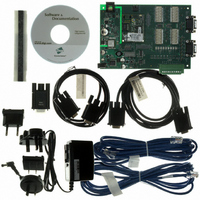DC-EM-KT Digi International, DC-EM-KT Datasheet - Page 117

DC-EM-KT
Manufacturer Part Number
DC-EM-KT
Description
KIT INTEGRATION EM FOR S MODELS
Manufacturer
Digi International
Series
Digi Connect EM®r
Type
MCU Moduler
Specifications of DC-EM-KT
Contents
Module with plug-and-play firmware, Development Board, Documentation, CD, Cables and Power Supply
For Use With/related Products
Digi Connect EM S Module
Lead Free Status / RoHS Status
Contains lead / RoHS non-compliant
Other names
602-1003
DC-EM-01T-KT
DC-EM-02T-KT
DC-EM-01T-KT
DC-EM-02T-KT
- Current page: 117 of 155
- Download datasheet (3Mb)
–
–
–
–
set alarm: The “set alarm” command displays current alarm settings, including
the conditions which trigger alarms, and how the alarms are sent, either as an
email message, an SNMP trap, or both. The alarms can be reconfigured as
needed.
set gpio: The “set gpio” command displays current GPIO pin settings. The pin
settings can be reconfigured as needed.
set buffer and display buffers: These commands can be used to display port-
buffering-related information. The “set buffer” command both configures
buffering parameters on a port and displays the current port buffer
configuration. The “display buffers” command displays the contents of a port
buffer, or transfers the port-buffer contents to a server running Trivial File
Transfer Protocol (TFTP).
set snmp: Configures SNMP, including SNMP traps, such as authentication
failure, cold start, link up, and login traps. This command also displays current
SNMP settings.
status: Displays a list of sessions, or outgoing connections made by connect,
rlogin, or telnet commands for a device. Typically, the status command is used
to determine which of the current sessions to close.
who: The who command provides a global list of connections. Currently, this
list of connections includes those associated with a serial port or the command-
Serial statistics. The “info serial” command displays the number of bytes
received and transmitted, signal changes, FIFO and buffer overruns, framing
and parity errors, and breaks detected.
TCP statistics. The “info tcp” command displays the number of segments
received or sent, the number of active and passive opens, the number of bad
segments received, the number of failed connection attempts, the number of
segments retransmitted, and the number of established connections that have
been reset.
UDP statistics. The “info udp” command displays the number of datagrams
received or sent, bad datagrams received, and the number of received
datagrams that were discarded because the specified port was invalid.
Wireless statistics. The “info wlan” command displays detailed statistics for
wireless devices that may aid in troubleshooting network communication
problems with a wireless network.
M o n i t o r i n g D i g i C o n n e c t D e v i c e s
1 1 7
Related parts for DC-EM-KT
Image
Part Number
Description
Manufacturer
Datasheet
Request
R

Part Number:
Description:
KIT DEV EM MOD NO RAVEN DEBUG
Manufacturer:
Digi International
Datasheet:

Part Number:
Description:
KIT JUMP START EM FOR NET+OS 7.X
Manufacturer:
Digi International
Datasheet:

Part Number:
Description:
KIT DEV EM MODULE C MODELS
Manufacturer:
Digi International
Datasheet:

Part Number:
Description:
BOARD DEV EM MODULE JTAG WI-ME
Manufacturer:
Digi International
Datasheet:

Part Number:
Description:
EM 8MB SDRAM 4MB FLASH SINGLE
Manufacturer:
Digi International
Datasheet:

Part Number:
Description:
EM 8MB SDRAM 4MB FLASH SINGLE
Manufacturer:
Digi International
Datasheet:

Part Number:
Description:
EM 8MB SDRAM 4MB FLASH SINGLE
Manufacturer:
Digi International

Part Number:
Description:
EM 8MB SDRAM 4MB FLASH SINGLE
Manufacturer:
Digi International
Datasheet:

Part Number:
Description:
EM 8MB SDRAM 4MB FLASH 25 PAK
Manufacturer:
Digi International

Part Number:
Description:
EM 8MB SDRAM 4MB FLASH 25 PAK
Manufacturer:
Digi International

Part Number:
Description:
EM 8MB SDRAM 4MB FLASH 25 PAK
Manufacturer:
Digi International

Part Number:
Description:
EM 8MB SDRAM 4MB FLASH SINGLE
Manufacturer:
Digi International

Part Number:
Description:
Networking Modules & Development Tools EM Intergration Kit for S Modules
Manufacturer:
Digi International
Datasheet:

Part Number:
Description:
KIT INTEGRATION WI-EM S MODELS
Manufacturer:
Digi International
Datasheet:










